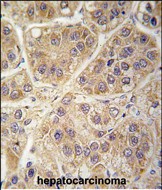

| WB | 咨询技术 | Human,Mouse,Rat |
| IF | 咨询技术 | Human,Mouse,Rat |
| IHC | 1/100-1/500 | Human,Mouse,Rat |
| ICC | 技术咨询 | Human,Mouse,Rat |
| FCM | 咨询技术 | Human,Mouse,Rat |
| Elisa | 咨询技术 | Human,Mouse,Rat |
| Aliases | Serine--tRNA ligase, mitochondrial, SerRSmt, Seryl-tRNA synthetase, SerRS, Seryl-tRNA(Ser/Sec) synthetase, SARS2, SARSM |
| Entrez GeneID | 54938 |
| WB Predicted band size | 58.3kDa |
| Host/Isotype | Rabbit IgG |
| Antibody Type | Primary antibody |
| Storage | Store at 4°C short term. Aliquot and store at -20°C long term. Avoid freeze/thaw cycles. |
| Species Reactivity | Human |
| Immunogen | This SARS2 antibody is generated from rabbits immunized with a KLH conjugated synthetic peptide between 315-344 amino acids from the Central region of human SARS2. |
| Formulation | Purified antibody in PBS with 0.05% sodium azide,1%BSA and 50% glycerol.prepared by Saturated Ammonium Sulfate (SAS) . |
+ +
以下是3篇与SARS-CoV-2抗体相关的文献概述:
1. **《Structural basis for potent neutralization of SARS-CoV-2 by a non-RBM-targeting antibody》**
- 作者:Liu H. et al.
- 摘要:解析了一种靶向病毒刺突蛋白非受体结合域(RBM)的人源单克隆抗体的结构,揭示其通过稳定刺突蛋白三聚体构象阻断病毒入侵的机制,为广谱抗体制剂设计提供依据。
2. **《Antibody evasion by the P.1 strain of SARS-CoV-2》**
- 作者:Wang Z. et al.
- 摘要:通过血清学实验证明巴西变异株P.1(Gamma)对康复者血清及部分单克隆抗体的中和活性显著降低,揭示了病毒突变对抗体治疗的潜在威胁。
3. **《Broadly neutralizing antibodies against SARS-CoV-2 and other human coronaviruses》**
- 作者:Pinto D. et al.
- 摘要:筛选出能够交叉中和SARS-CoV-2、SARS-CoV及MERS-CoV的单克隆抗体,其靶向刺突蛋白的保守表位,为通用冠状病毒疫苗研发奠定基础。
4. **《Persistent antibody responses to SARS-CoV-2》**
- 作者:Dan J.M. et al.
- 摘要:追踪感染者长达8个月的抗体动态,发现中和抗体水平在康复后缓慢下降但长期存在,提示自然感染可能诱导持久的免疫记忆。
**Background of SARS-CoV-2 Antibodies**
SARS-CoV-2 antibodies are proteins produced by the immune system in response to infection by SARS-CoV-2 (the virus causing COVID-19) or vaccination. These antibodies, primarily immunoglobulin G (IgG), IgM, and IgA, play critical roles in neutralizing the virus, blocking its entry into host cells, and marking it for destruction. Neutralizing antibodies target the viral spike (S) glycoprotein, particularly its receptor-binding domain (RBD), which mediates entry into human cells via ACE2 receptors.
Following infection or vaccination, IgM antibodies typically appear within 1–2 weeks as an early immune response, followed by IgG, which provides longer-term protection. IgA antibodies are crucial for mucosal immunity in the respiratory tract. Antibody levels and durability vary, influenced by factors like disease severity, age, and immune status. While most individuals retain detectable antibodies for several months, levels may decline over time, necessitating booster vaccines to sustain immunity.
Antibody testing (serology) helps identify past infections, assess vaccine efficacy, and guide public health strategies. However, antibodies alone do not guarantee sterilizing immunity, as T-cell responses also contribute to protection. Emerging variants with spike protein mutations challenge antibody effectiveness, driving research into updated vaccines and monoclonal antibody therapies. Despite advances, ongoing surveillance is essential to address viral evolution and optimize therapeutic approaches.
×